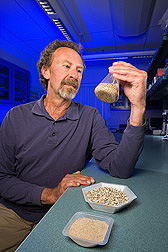
by Allison Younkins
Healthier spinach, just add light
Spinach, or Spinacia oleracea, is one of the most nutritious vegetables found in the grocery store. Normally packaged in a clear plastic container, most spinach leaves are exposed to fluorescent supermarket lights for up to 24 hours a day. Surprisingly, a study published in March in the Journal of Agricultural and Food Chemistry shows that the light exposure boosts the vegetable’s nutritional content to astonishing levels. Scientists at the Kika de la Garza Subtropical Agricultural Research Center and the Atlantic Food and Horticulture Research Centre conducted an experiment to test the affect of lighting on the nutritional value of spinach. They exposed spinach to either continuous light or darkness while under simulated supermarket storage conditions for up to 9 days. Even spinach leaves exposed to the fluorescent lighting for only three days showed significant increases in important vitamins and antioxidants. The leaves exposed to nine days of light had increased folate levels by 84-100% and levels of vitamin K between 50-100%. Even further, the group exposed to no light had declining nutritional values.
How light contributes to nutrition: the connection
The main researcher on this project, Gene Lester of the USDA Agricultural Research Service, explains how supermarket lighting can contribute to vitamin and mineral levels within the leaves of this powerhouse plant. Lester clarifies that although a leaf has been detached from the original plant, it can still undergo the process of photosynthesis. The lighting in supermarkets allows the spinach leaves to continue creating vitamins and minerals as they would naturally. Lester comments, “As long as there is moisture in the leaves and as long as there is gas exchange and light, it is good to go whether they are picked or not.”
How other vegetables and consumers can benefit from this study
The most exciting implication of these results is that other vegetables may receive the same benefits from fluorescent lighting. Keeping vegetables fresh in grocery stores is a constant struggle, and additional studies may illuminate more effective storage solutions. One serving of spinach currently provides 20% of your daily recommendation for vitamins C, A, B9, K, and E but with further research soon you may be getting more bang for your nutritional buck!
Want to learn more? Check out the resources I used for this blog:
Supermarket lighting enhances nutrient level of fresh spinach
